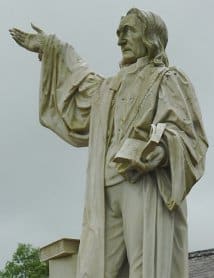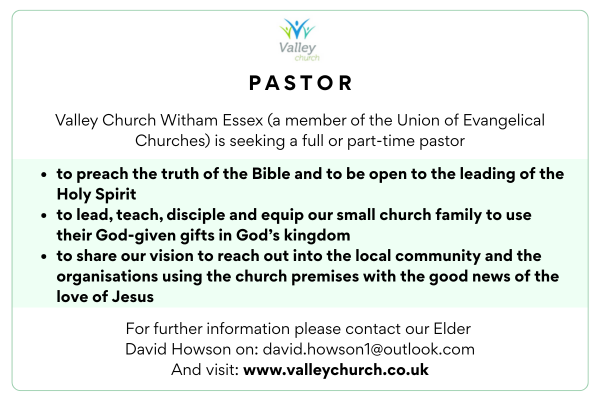Statue of Daniel Rowland at Llangeitho, Ceredigion (Roger Kidd) / CC BY-SA 2.0
Welsh Calvinistic Methodism — a denomination and a declaration
It was an occasion that passed largely unnoticed outside Wales, but 2011 marked the anniversary of an event of great significance for the Welsh Calvinistic Methodists.
Two hundred years ago, they took the decisive step of ordaining their own ministers for the very first time. In so doing, they established a separate denomination independent of the Church of England, and they created what was to become a remarkably powerful force in the religious, social and cultural life of Wales.
Welsh
The story of the Welsh Calvinistic Methodists goes back beyond 1811 to the 1730s, with the conversion of such men as Howel Harris, Daniel Rowland and William Williams Pantycelyn.
This was a time of revival in America, through the ministry of Jonathan Edwards — a Calvinistic Methodist in all but name (and of Welsh descent to boot!). England also knew something of the same spiritual stirrings, with the conversion first of George Whitefield and then of the Wesley brothers, although the latter were decidedly Arminian rather than Calvinistic in their beliefs.
Despite opposition from the ecclesiastical establishment, the early Methodist leaders of Wales and England had no desire to leave the Anglican Church. Among many second and third generation Methodists, however, there were signs of increasing tension and frustration in their relationship with the anti-evangelicals in the Church of England.
The Wesleyan Methodists eventually broke away in the 1790s. And in 1811 — not without much heart-searching — the Welsh Calvinistic Methodists did likewise.
The term ‘Calvinistic Methodism’, however, has a significance that extends far beyond the borders of a particular denomination. Indeed, it might be argued that the very name provides a superb declaration of God-centred Christianity, in all places and all periods.
Let’s look at its two elements, in turn.
Calvinistic
The heart of Calvinism is not, as many seem to think, an emphasis on election and predestination. Rather, it is the glory of God — his majesty, honour, sovereignty in all and over all, and his marvellous grace.
Everything is to be understood in the light of these truths concerning God. His glory is to be seen in the wonders of his works of creation, and in the ways in which he rules over all things through his wise and all-embracing providence.
It is at its most dazzling in his gracious determination to accomplish the salvation of a great host of unlovely and rebellious sinners, through the atoning work of Jesus Christ for them on the cross, and the regenerating and preserving work of the Holy Spirit within them.
In complete accord with the Bible, John Calvin insisted that true religion must be God-centred. Anything less does God a great injustice. In focusing on his inexpressible glory, the doctrines of Calvinism inspire redeemed sinners to worship the Lord with godly fear and overflowing joy. They provide a solid anchor and vital hope in the midst of all the trials and tribulations of this present world, and serve as a powerful incentive for honouring God in every aspect of daily life.
Methodist
In the eighteenth century, the term ‘Methodist’ was used to mock those who, claiming to have been born again, gave eager and vibrant expression to their new spiritual life.
In the words of Williams Pantycelyn, for instance, Howel Harris suddenly appeared on the scene mewn twym ias (‘in a thrill of fervour’), which manifested itself in a burning desire to preach the gospel in the face of all kinds of persecution.
If Harris was a prime example of the life-giving power of the Holy Spirit, all Methodists could speak of the same experience in their own souls.
Gathered together in the seiadau (society or experience meetings), they were given instruction in the faith and encouraged to seek an ever deeper relationship with God, in Christ.
There was indeed an earlier meaning to the word ‘Methodist’. It was first used to make fun of the Wesley brothers and other members of the ‘Holy Club’ at Oxford University.
At the time, these students did not understand the gospel. Rather, they were devoted — in an earnest and ‘methodical’ manner — to all kinds of religious activities and humanitarian works.
In origin, therefore, Methodist referred to a practical way of life, with an emphasis on wholehearted consecration to disciplined service.
When members of the Holy Club subsequently came to embrace the gospel, the name Methodist stuck to them, but was now increasingly associated with their new spiritual experience as indicated above.
Today
The term ‘Calvinistic Methodism’, then, speaks of a body of God-glorifying doctrine, a life-giving and life-changing experience of God’s grace, and a thoroughgoing desire to honour God in every aspect of daily living.
It represents what is to be believed, experienced and worked out in practice. To put it another way, it emphasises that true Christianity is a religion of the head, heart and hands/feet. In other words, the expression represents the very essence of God-centred Christianity.
Back in the 1930s, to the chagrin of many faithful ministers and members within its ranks, the Welsh Calvinistic Methodists decided to adopt a new title, namely ‘The Presbyterian Church of Wales’.
It is difficult not to see something symbolic here. The doctrine, the experience and the practical Christian living were abandoned, at least as far as the name of the denomination was concerned, and replaced by a mere system of church government.
There are encouraging signs of re-emerging spiritual life in the Presbyterian Church of Wales today, especially among younger ministers. But ‘Calvinistic Methodism’ is far more than a mere denominational matter. It stands as a remarkable testimony to what God accomplished in Wales, particularly in the eighteenth and nineteenth centuries.
Still more important, the name is a vivid declaration of the essence of God-centred Christianity in every generation.
Gwyn Davies
This is an amended version of an article first published in Welsh in Y Cylchgrawn Efengylaidd, autumn 2011.








